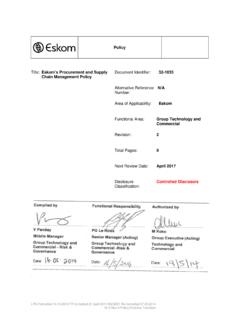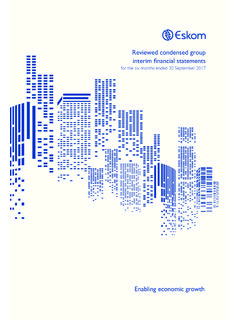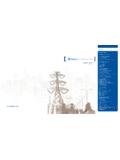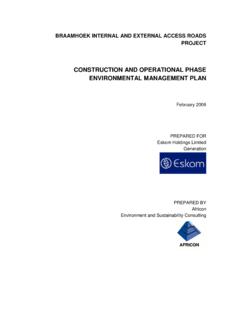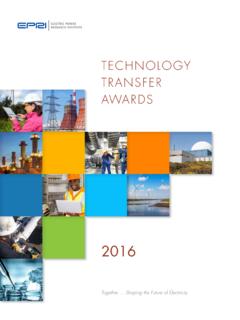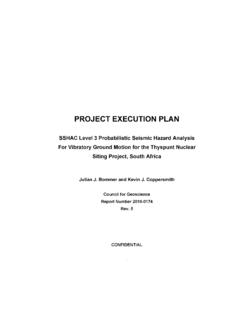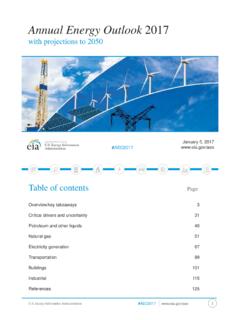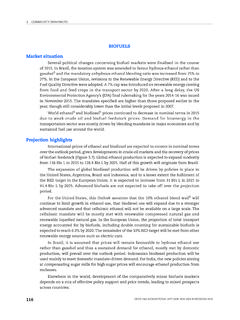Transcription of Medium-term System Adequacy Outlook 2017 to 2021
1 Medium-term System Adequacy Outlook 2017 to 2021 31 July 2017 2 Contents 1. Overview .. 3 2. Introduction .. 3 3. Methodology and approach .. 3 4. Assumptions .. 5 demand forecast .. 5 Existing and committed supply resources .. 7 Eskom installed 7 New build commercial operation dates .. 8 Non-Eskom capacity without the 9 10 demand -side 10 Eskom plant performance .. 10 5. Modelling scenarios .. 12 6. Results and conclusion .. 13 7. Glossary and abbreviations .. 14 List of figures Figure 1: MTSAO methodology .. 5 Figure 2: energy demand forecast .. 6 Figure 3: Comparison of historical and forecast demand .. 7 Figure 4: Plant performance for July 2017 MTSAO .. 11 Figure 5: April 2016 and July 2017 MTSAO, % EAF Comparison .. 11 Figure 6: Scenarios Considered .. 12 Figure 7: Forecasted excess capacity (MW) from 2017 to 2021.
2 13 List of tables Table 1: Adequacy metrics .. 4 Table 2: energy demand forecast comparison in GWh .. 6 Table 3: Eskom installed capacity .. 7 Table 4: Medupi Power Station unit commercial operation dates .. 8 Table 5: Kusile Power Station unit commercial operation dates .. 9 Table 6: Non-Eskom supply sources, including imports (MW) .. 9 Table 7: REIPPP committed 10 3 1. Overview The South African Grid Code System Operation Code, Version , requires on or before 30 October of each year, the System Operator shall publish a review (called the medium Term System Adequacy Outlook ) of the Adequacy of the Interconnected Power System (IPS) to meet the long term (5 year future) requirements of electricity consumers . This review will be limited to the Adequacy of the generation System for the Republic of South Africa.
3 At the request of NERSA, Eskom System Operator has produced a mid-year view of the Medium-term System Adequacy Outlook (MTSAO) for the period 2017 to 2021. This is not a comprehensive study, but only investigated a limited number of future scenarios. A more comprehensive MTSAO covering the period 2017 to 2022 as per the Grid Code requirements will be published in October 2017 . The October MTSAO will consider inputs and comments by NERSA and other interested parties. 2. Introduction The MTSAO provides a statement of generation Adequacy to meet the expected electricity demand for the next five years (calendar years 2017 to 2021). The Adequacy to transmit and distribute electricity does not form part of the MTSAO. The study determines the Adequacy of the System to meet the expected demand of the country, made up of a combination of local consumption and exports.
4 This demand is satisfied by a combination of all generation resources licensed by NERSA, imports, and demand -side management resources. 3. Methodology and approach The South African IPS is assessed based on the System Adequacy metrics, as shown in Table 1 below. The Adequacy metrics are chosen to provide information on the operational capacity and energy Adequacy of the generation System to meet expected demand . The threshold for each of the metrics is set at the point of least total cost to the consumer. The Adequacy metrics, as shown in Table 1 below, indicate both capacity and energy contingencies. Capacity-type contingencies, on the one hand, look at unexpected load increases, short-duration events (hours), as well as just sufficient capacity to supply demand , and lead to imbalances between supply and demand .
5 energy -type contingencies, on the other hand, look at higher-than-forecast load growth or loss of a large supply source, longer duration (weeks/months), as well as just sufficient baseload plant to supply load on a continuous basis, and lead to imbalances between supply and demand . 4 Table 1: Adequacy metrics The System is deemed adequate only if all System Adequacy metrics in Table 1 above are satisfied. Should any of the Adequacy metrics not be met, additional resources are added, as shown in Figure 1; these resources are quantified in terms of baseload, mid-merit, and peaking capacity in MW. 5 Figure 1: MTSAO methodology Available generation and demand response resources, both existing and new when in commercial operation, are dispatched to meet expected demand on an hourly basis for all hours in the study period.
6 The dispatch is done on a least-cost basis and adheres to all System requirements ( demand and reserves), resource constraints (generator capabilities), and the generator/ demand response owner dispatch regime. 4. Assumptions Key assumptions are based on demand forecast, existing and committed supply resources, and plant performance. demand forecast Two country-level demand forecasts were developed internally in Eskom, namely, the moderate growth demand forecast and the high demand forecast, shown below in Figure 2 and Table 2. The moderate growth forecast provides the base case, which has an average growth rate of The high demand forecast has an average annual growth rate of The South African actual energy demand for the 2016 calendar year was TWh, with a growth rate of relative to 2015.
7 6 Figure 2: energy demand forecast The moderate growth forecast takes account of current economic conditions, and forecasts increase in demand as a result of Eskom s drive to increase sales both locally and across the border. Moderate growth High January 2016 MTSAO 2017 246 500 246 500 248 607 2018 250 100 250 200 251 730 2019 256 100 256 500 252 532 2020 263 300 264 200 253 416 2021 269 300 272 100 252 826 Table 2: energy demand forecast comparison in GWh The South African electric power System was characterised by load shedding from as far back as 2008 up to 2015. This was due to a higher plant failure rate amid slippages in commissioning new committed capacity, which reduced available generation supply to meet demand . Figure 3 below shows that actual demand has remained practically the same since 2008 due to System constraints, load shedding, slow economic growth, higher prices, and energy efficiency measures that have been implemented by the industry since 2008.
8 GROWTH RATE (%) energy (TWH)CALENDAR YEARSE nergy demand ForecastModerate Growth RateHigh Growth RateModerateHighApril 2016 MTSAO Forecast7 Figure 3: Comparison of historical and forecast demand Existing and committed supply resources Generation resources and demand -side initiatives are both used to meet the forecast demand . The capacities of the generation resources are, furthermore, grouped in terms of Eskom installed capacity, new build commissioning dates, non-Eskom capacity without the Renewable energy Independent Power Producer Programme (REIPPP), and REIPPP capacity. Eskom installed capacity Total Eskom installed capacity consists of coal, nuclear, pumped storage, diesel, hydro, and wind. For the purposes of the MTSAO, a conservative view was taken that coal-fired power stations would reach the end of their economic live after 50 in line with the IRP2010.
9 Table 3 depicts the Eskom installed capacity over the study horizon, but excludes Medupi and Kusile. Rate [%] energy [TWh]Calendar YearsHistorical energy vs energy demand ForecastActual energy Growth RateModerate Growth RateHigh Growth RateActual EnergyModerate GrowthHighApril 2016 MTSAO ForecastAAR (1990-2007): AAR (2008-2016): 8 2017 2018 2019 2020 2021 Coal 35 795 35 795 35 795 35 238 34 307 Nuclear 1 860 1 860 1 860 1 860 1 860 Pumped storage 2724 2 724 2 724 2 724 2 724 Diesel 2 409 2 409 2 409 2 409 2 409 Hydro 600 600 600 600 600 Wind 100 100 100 100 100 43 488 43 488 43 488 42 931 42 000 Table 3: Eskom installed capacity New build commercial operation dates The official commercial operation dates (CoDs) for Medupi and Kusile are a blend of P50 dates for the first three units and P80 for the last three units.
10 The study also used the expected CoDs, based on the current construction performance of the New Build Programme, as a scenario. The current construction performance of new committed generated capacity has resulted in full commercial operation of Ingula, earlier than assumed in the previous MTSAO study, commercial operation of Medupi s Unit 5, and earlier synchronisation of Kusile s first unit, further increasing available supply. Station unit Official CoD Expected CoD April 2016 MTSAO CoD MEDUPI Unit 6 Commercial Commercial Commercial Unit 5 Commercial Commercial 2018-March Unit 4 2017 -Dec 2017 -Dec 2018-July Unit 3 2019-Jun 2019-Jun 2019 Jun Unit 2 2019-Dec 2019-Dec 2019 Dec Unit 1 2020-May 2020-May 2020-May Table 4: Medupi Power Station unit commercial operation dates Table 4 above and Table 5 below show that, relative to the April 2016 MTSAO CoD submission, Medupi Unit 5 added additional capacity to the grid earlier than projected in April 2016, and the commercial operation of Kusile Unit 1 was brought forward.
